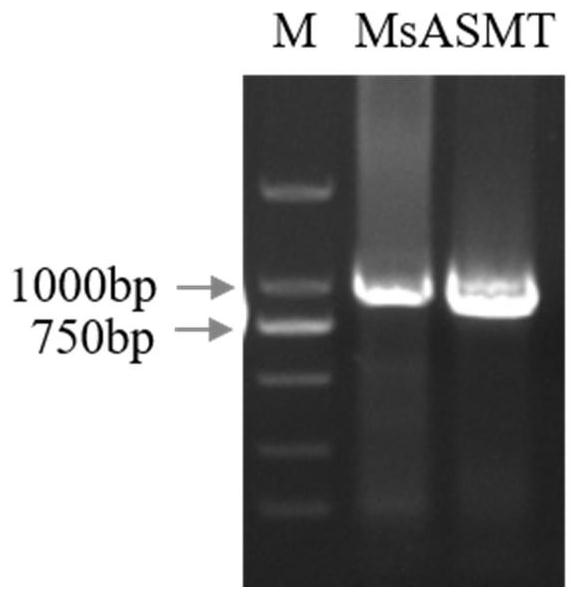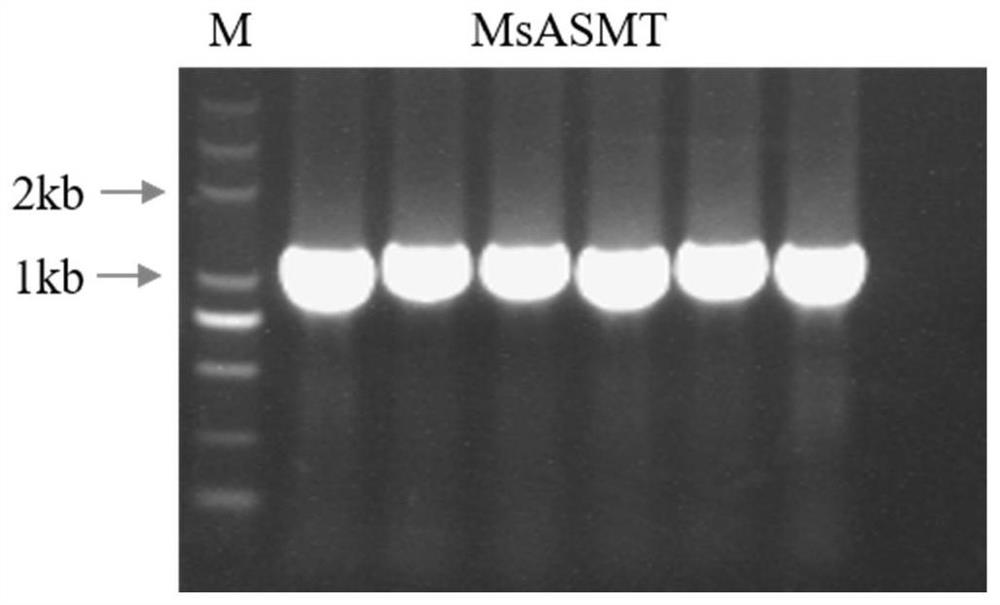Alfalfa melatonin synthesis gene msasmt and its application in regulating the synthesis of melatonin and flavonoids in plants
A technology of alfalfa and melatonin, applied in the field of genetic engineering, can solve the problems of cloning, expression and application of the key enzyme gene for melatonin synthesis, and the growth and development regulation function of endogenous melatonin.
- Summary
- Abstract
- Description
- Claims
- Application Information
AI Technical Summary
Problems solved by technology
Method used
Image
Examples
Embodiment 1
[0044] Example 1 Cloning of alfalfa melatonin synthesis key enzyme gene MsASMT
[0045] Cloning of alfalfa melatonin synthesis key enzyme gene MsASMT comprises the following steps:
[0046] 1. Extraction of total RNA from alfalfa leaves and synthesis of cDNA
[0047] (1) Take about 100 mg of the leaves of alfalfa seedlings Zhongmi No. 1, grind them into powder in liquid nitrogen, and extract the total plant RNA according to the Trizol method. After verification by agarose gel electrophoresis, high-quality RNA with complete 28S and 18S was obtained. And measure RNA concentration and purity with Nanodrop2000, OD 260 / OD 280 All between 1.8-2.0, OD 260 / OD 230 All >2.0, it proves that the obtained RNA is of good quality and can be used for the synthesis of the first strand of cDNA and the cloning of downstream genes.
[0048] (2) Using 1 μg of the above RNA sample as a template, use the PrimeScript RT reagent Kit (TaKaRa) kit to carry out reverse transcription according to t...
Embodiment 2
[0068] Construction of embodiment 2 MsASMT overexpression vector and acquisition of transgenic alfalfa
[0069] This example provides the construction of an overexpression vector for the key enzyme gene MsASMT in the synthesis of alfalfa melatonin and the method for obtaining transgenic alfalfa, which specifically includes the following steps:
[0070] 1. Construction of MsASMT plant overexpression vector
[0071] (1) Extract the plasmid from the Escherichia coli liquid containing the pMD18T-MsASMT plasmid with correct sequencing using the TaKaRa plasmid mini-extraction kit, and measure the concentration of the plasmid with NanoDrop2000.
[0072] (2) Since the upstream and downstream primers of gene cloning have restriction enzyme recognition sites of BamH I and Kpn I respectively, these two enzymes were selected to perform double enzyme digestion on the correctly sequenced plasmid samples and the plant overexpression vector pZh01, respectively. The system is as follows: 1 μg o...
Embodiment 3
[0094] Example 3 Phenotype and biological function analysis of transgenic alfalfa
[0095] 1. Analysis of melatonin content in transgenic alfalfa
[0096] Take about 1.5-2 g of the above-ground parts of the wild type and each transgenic plant, and repeat 3 times for each plant. After grinding with liquid nitrogen, leaching with methanol overnight, centrifuging at 8000 g for 10 min, passing the supernatant through a 0.25 μm filter membrane into a brown vial, using high-efficiency The content of melatonin in each transgenic and wild-type alfalfa was determined by liquid chromatography (HPLC). The result is as Figure 8 As shown, the melatonin content in the transgenic alfalfa overexpressing MsASMT was significantly increased. Using SPSS to analyze the correlation between the level of melatonin and the expression of MsASMT gene, the correlation coefficient is 0.720, and the corresponding significance is 0.029, indicating that there is a significant positive correlation between ...
PUM
 Login to View More
Login to View More Abstract
Description
Claims
Application Information
 Login to View More
Login to View More - R&D
- Intellectual Property
- Life Sciences
- Materials
- Tech Scout
- Unparalleled Data Quality
- Higher Quality Content
- 60% Fewer Hallucinations
Browse by: Latest US Patents, China's latest patents, Technical Efficacy Thesaurus, Application Domain, Technology Topic, Popular Technical Reports.
© 2025 PatSnap. All rights reserved.Legal|Privacy policy|Modern Slavery Act Transparency Statement|Sitemap|About US| Contact US: help@patsnap.com



